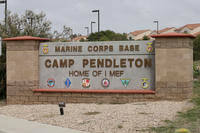MARINE CORPS AIR STATION BEAUFORT, S.C. - Marine Wing Support Squadron 273 and Marine Air Control Squadron 2, Detachment A participated in a joint forward arming and refueling point exercise with the South Carolina Air National Guard at the McEntire Joint National Guard Base, Feb. 24-28.
During the exercise, Marines performed assault landing zone operations, as well as, helicopter landing zone operations with SCANG.
Assault landing zones and helicopter landing zones are expeditionary landing sites that air traffic control Marines use in a deployed environment.
Before setting up the ALZ and HLZ a site survey must first be conducted. This allows ATC Marines to determine conditions are right for aircraft to land in the area.
Conditions include wind direction and, for an ALZ, they also need to survey if the ground is stable enough to support aircraft such as a C-130.
McEntire is a self-supporting installation that is uniquely situated to provide multiple training opportunities for joint military and civilian operations.
"We were proud to offer our support to the United States Marines in this important exercise,” said Col. Michael Manning, commanding officer of the 169th Fighter Wing at McEntire Joint National Guard Base. “Any chance we have to train with our sister-service counterparts is an opportunity to share knowledge which in turn promotes cohesiveness during future operations or contingencies.”
According to 1st Lt. Christopher Spotts, the air traffic manager for the 245th Air Traffic Control Squadron and project officer for the FARP exercise, joint operations are important because that is now the way of the world in theater and home-station operations.
"Many bases have already transitioned to the joint base concept and more will in the future," said Spotts. "Exercises like this FARP allow us to interact with other services and will prove beneficial during actual deployment operations.”
By hosting the Marines, the exercise gave soldiers at McEntire the opportunity to trade information and practices. Each military branch does things differently but the common thread is achieving the mission.
Soldiers learned Marine Corps hand and arm signals, while Marines got familiar with different aircraft such as the UH-60 Black Hawk.
“It also allows us to see how the Army conducts business,” said Staff Sgt. Enrique Pacheco, the operations chief for the MWSS-273 Air Operations Company. “It also allows them to get to know our standard operating procedures, so that they know what to expect when they are in an actual FARP with a Marine Corps unit overseas.”
Air traffic control Marines got a lot from the exercise as well.
“This [exercise] allowed their aircrew to maintain critical task proficiency, as well as expose our air traffic controllers to a type of operation they usually only experience at overseas locations.”
With more and more bases transitioning to the joint military status, exercises that bring together and benefit multiple branches of the military can increase the cohesiveness during future operations or contingencies.



















